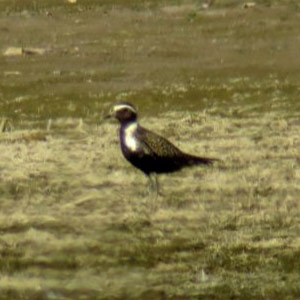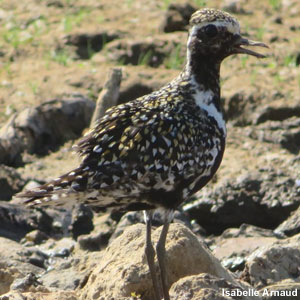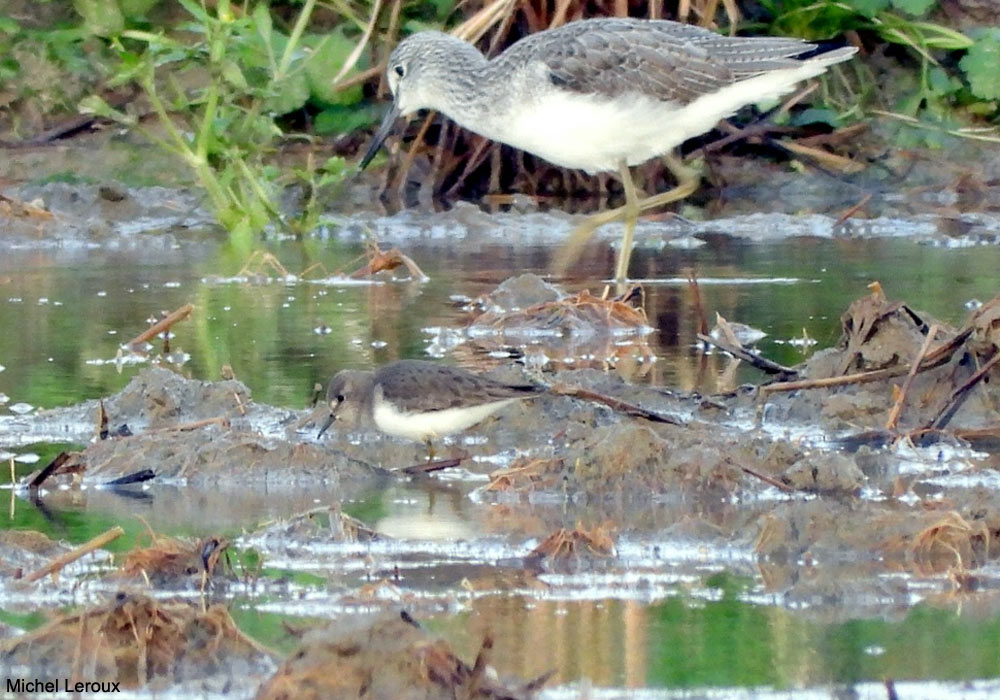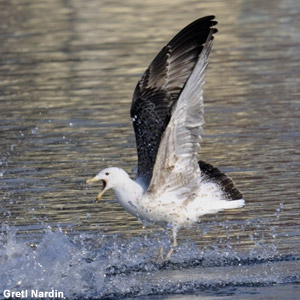Pratique | Identification
Identification d’un Pluvier bronzé adulte en Alsace en juin 2019

Pluvier bronzé (Pluvialis dominica) adulte en plumage nuptial, plan d’eau de Plobsheim (Bas-Rhin), le 13/06/2019.
Photographie : Denis Dujardin
Introduction
L’identification des différentes espèces de pluviers (genre Pluvialis) est souvent problématique, même dans le cas d’adultes en plumage nuptial. Le 13 juin 2019, alors qu’il observait les oiseaux sur le plan d’eau de Plobsheim (Bas-Rhin), Denis Dujardin a repéré un oiseau isolé sous le soleil du matin qui avait rendu les couvertures sous-alaires et les aisselles (axillaires) très claires, et il l’avait donc identifié comme étant un Pluvier doré (P. apricaria). Une nouvelle visite en fin d’après-midi lui a permis de mieux distinguer les teintes gris-brun du dessous des ailes. Par ailleurs, la grande étendue de blanc sur les côtés du cou, la longue projection primaire, les motifs et les couleurs des parties supérieures, la date atypique pour un Pluvier doré adulte et les avis d’autres observateurs l’ont conduit à l’identifier comme étant un Pluvier bronzé (P. dominica) adulte en plumage nuptial, une espèce nord-américaine accidentelle en Europe.
Après une description de cette observation remarquable si loin à l’intérieur des côtes, nous rappelons les critères permettant de différencier les Pluviers bronzé, fauve, doré et argenté adultes en plumage nuptial. Nous remercions Denis Dujardin pour ses photos et ses informations, ainsi que tous les autres photographes qui nous ont permis d’illustrer cet article et dont les noms figurent sous leurs clichés.
Abstract
The identification of different species of plovers (genus Pluvialis) is often problematic, even in the case of adults in almost perfect breeding plumage. The 13th of June 2019, while watching birds on the Plobsheim reservoir, in the department of Bas-Rhin, Eastern France, Denis Dujardin found an isolated plover, which presented very clear underwing covers and axillaries under the morning sun, and which he thus identified as a European Golden Plover (P. apricaria). A new visit in the afternoon allowed him to better distinguish the gray-brown hues of the underwings. The large extent of white on the neck, the long primaries, the patterns and colors of the upperparts, the atypical date and the opinions of other birders led him to identify the bird as an adult American Golden Plover (P. dominica), an accidental North American vagrant in Europe.
After a presentation of this remarkable record, so far from the Atlantic Ocean or the Channel coasts, we enumerate the field criteria to distinguish the breeding adults of the European Golden, Grey, American Golden and Pacific Golden Plovers. We thank Denis Dujardin and all the other photographs.
Poursuivez la lecture de cet article, en vous abonnant dès maintenant !
Découvrez les Archives d’Ornithomedia.com
Pour seulement 10,00 €TTC/an (ou 6,00 € les 6 mois)
Profitez de plusieurs centaines d’articles en accès illimité et sans aucun engagement.
Compléments
À lire aussi sur Ornithomedia.com
- Distinguer les Pluviers fauve et doré adultes en plumage nuptial
- Identifier les limicoles communs en Europe : seconde partie
- Observer les oiseaux en hiver dans la vallée du Rhin
Dans la rubrique Observations d’Ornithomedia.com
Pluvier bronzé (Pluvialis dominica)
Dans la galerie d’Ornithomedia.com
Pluvier bronzé (Pluvialis dominica)
À lire sur le web
- Le site web de la liste de diffusion ObsAlsace : https://alsace.lpo.fr
- Le site web collaboratif www.faune-alsace.org
- Le site web du Comité d’Homologation National : www.chn-france.org
Ouvrages recommandés
- Le guide Ornitho Killian Mullarney et al
- The Handbook of Bird Identification: For Europe and the Western Palearctic de Mark Beaman, Steve Madge
- Guide des limicoles d’Europe, d’Asie et d’Amérique du Nord Stephen Message et Don Taylor
Sources
- Andy Stoddart (2018). Golden plover photo ID guide. Date : 14/07. www.birdguides.com/articles/golden-plover-photo-id-guide/
- Mark Beaman et Steve Madge (2010). The Handbook of Bird Identification: For Europe and the Western Palearctic. Pacific Golden Plover. Pages : 308-309.
- Alvaro Jamarillo (2004). Featured photo identification of adult Pacific and American Golden Plovers in their southbound migration. Western Birds. Volume : 35. Pages : 120 – 124. www.researchgate.net







Aucun commentaire sur ce sujet
Participer à la discussion !